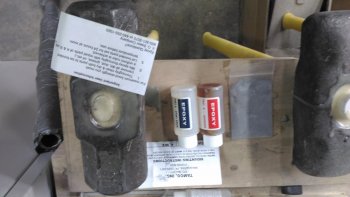Wayne Bensinger
Well-Known Member
Good morning all,
Seams I have a bit of an issue with a knife I just completed and was hoping for some input from anyone who'd be willing to help.
I recently came home from work and while getting out of the truck with way to much in my hands, as always, I dropped the new hunting knife I had just finished handle end down, right on the blacktop driveway. Needless to say, I saw red. So I start to inspect the G-10 handle and of course there's a couple of small divits and bruises on it, but nothing I can't easily remove.
Then I notice that both of the brass inserts between the bolster and the G-10 were popped loose and one actually fell out in my hand with a little help from my finger nail.
Here's a bit about the knife to help with any thoughts you guys may have.
440C, 304 s.s. bolsters, .080 brass insert between bolster and G-10 handle material, full tang. I'm using the 30 minute epoxy from Mid-west Knifemakers Supply. There is no mechanical bond between the brass and any other portion of the knife, just the epoxy bond. The bolsters are pinned and the G-10 has bolts.
I sand all surfaces to be epoxied with 80 grit first and then clean them with alcohol and assembled the handed, and I used a lot of epoxy. Everything gets wiped down with the alcohol rag to clean up the squeeze out. Everything gets clamped together for two days.
Never had this type of thing happen before, but had a couple of initial thought. First, I wonder if I should not be using the alcohol or maybe I'm using to much of it? Small parts and seams may be getting to much around them and it ruins the bond.
Second, I had heard that epoxy should only be used for up to one year, after that the hold power is greatly compromised, never new if there was any truth to this so I kept using it, my epoxy is at least two years old.
I know there's someone on this forum that will know exactly what went wrong and I hope there's enough detail here to get a good idea of my problem.
thanks, Wayne
Seams I have a bit of an issue with a knife I just completed and was hoping for some input from anyone who'd be willing to help.
I recently came home from work and while getting out of the truck with way to much in my hands, as always, I dropped the new hunting knife I had just finished handle end down, right on the blacktop driveway. Needless to say, I saw red. So I start to inspect the G-10 handle and of course there's a couple of small divits and bruises on it, but nothing I can't easily remove.
Then I notice that both of the brass inserts between the bolster and the G-10 were popped loose and one actually fell out in my hand with a little help from my finger nail.
Here's a bit about the knife to help with any thoughts you guys may have.
440C, 304 s.s. bolsters, .080 brass insert between bolster and G-10 handle material, full tang. I'm using the 30 minute epoxy from Mid-west Knifemakers Supply. There is no mechanical bond between the brass and any other portion of the knife, just the epoxy bond. The bolsters are pinned and the G-10 has bolts.
I sand all surfaces to be epoxied with 80 grit first and then clean them with alcohol and assembled the handed, and I used a lot of epoxy. Everything gets wiped down with the alcohol rag to clean up the squeeze out. Everything gets clamped together for two days.
Never had this type of thing happen before, but had a couple of initial thought. First, I wonder if I should not be using the alcohol or maybe I'm using to much of it? Small parts and seams may be getting to much around them and it ruins the bond.
Second, I had heard that epoxy should only be used for up to one year, after that the hold power is greatly compromised, never new if there was any truth to this so I kept using it, my epoxy is at least two years old.
I know there's someone on this forum that will know exactly what went wrong and I hope there's enough detail here to get a good idea of my problem.
thanks, Wayne

